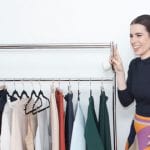Can’t Declutter; Won’t Declutter? Blame Your Brain…
Pain and pleasure: there’s a fine line between the two. Well, maybe not so much. According to brain boffins, the area in the noggin associated with pain lights up in the same way as it does when black sacking items to which you feel connected. Whether it’s those J Brand jeans you paid a small fortune for but never wore or those balding Isabel Marant Dicker boots that now boast winter air conditioning (see: gaping hole) – the pain of your wardrobe morphing into a recycling heap is easier to bear than saying ‘goodbye’. ‘All well and good’ I hear you say but how does one let go for good without someone like me talking you off the ledge? Got 60 seconds? It’s time for some straight ledge talking.

What’s done is done: So, you maxed out your heavily pregnant credit card on a dress that ironically made you look ‘in the family way’. Guess what? Holding onto the offending garment will not reimburse your Mastercard (if only); it will just serve as a bitter reminder of a bad choice. Behavioural economists refer to this brain flub as Sunk Cost Fallacy: basing trading decisions on price paid rather than prospective performance. As stated by Rolf Dobelli in The Art of Thinking Clearly, “Rational decision-making requires you to forget about the costs incurred to date. No matter how much you have already invested, only your assessment of the future costs and benefits count.” In other words: You’ve spent the money regardless. You will not get it back. You may as well make room in your life for something that actually serves you.
Feeling touchy? Lifehacker Mikael Cho unveils the impact of touch in the article How Clutter Happens. When we introduce a new item into our lives, we immediately assign it a value – personal, financial, emotional. Its worth, however arbitrary, therefore plays a factor in the decluttering process. What’s more, the more we touch something; the closer our bond, which would explain why divesting ourselves of clothing can be so acutely painful and why we are so attached to gadgets. The takeaway? We’ll always feel touchy about letting go. Learn to discern the difference between a keepsake and keeping something for the sake of it. Ascertain why you are holding onto it; how it currently serves you and if there is a future factor in keeping it. The Keep or Cull Audit in Chapter 7 of The Happy Closet provides an empirical checklist to help make that fine line more of a wide berth.
Give your brain a break and let it concentrate on more pleasing matters like the prospect of Bridgerton, Season 2!


